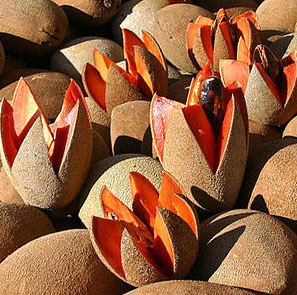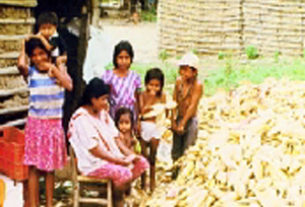Mexican Kitchen

The two little girls were standing at the side of the winding mountain road, surrounded by plastic buckets of something whose shape we could barely distinguish in the fading daylight. Trying to get to the next town before darkness set in, we nevertheless stopped to ask what they were selling. “Mamey” was the answer, as they pointed to the large, oval objects in the buckets, looking more like small footballs than fruit.
We had started out from Veracruz in the late afternoon and were driving through the tropical highlands toward the Sierra of Puebla. We had chosen a secondary road to see more of the countryside, and were about to discover a new and intriguing flavor. We now know that the month of February, when we made that drive twenty-something years ago, is the beginning of mamey season, and we would soon see piles of them in our local market.
Eager for something new to try, we bought a bucket of four or five pieces of fruit, which one of the girls emptied into a plastic bag. Once settled in a hotel room for the night, we peeled away the mamey’s rough, brown skin and cut into the orangey red pulp. The delicate, distinctive flavor was difficult to describe, but both my husband and I tried. Sweet potato, pumpkin, peach and even cherry flavors were some of the comparisons we made, but none of them were satisfactory. The taste of mamey, hard as it is to pin down, is a wintertime pleasure in Mexico.
Mamey, or Pouteria sapota, is native to tropical areas of Mexico and Central America. It is in the same botanical family, sapotaceae, as the zapote, another popular winter fruit. In fact, it is often called mamey zapote or zapote colorado. (It should not be confused with the Mammea americana, a fruit indigenous to Chiapas and Guatemala, also known as an “Antilles apricot,” smaller, rounder, with a darker skin and less sweet taste.)
A typical mamey can weigh anything from a quarter to more than a half pound, with a large, lustrous black pit, or hueso, accounting for about ten percent of its weight. The skin of the pit peels away to reveal a yellow kernel underneath, the fruit’s seed, which can easily be split in half lengthwise and carries a faint aroma of almonds.
The olfactory connection to almonds is due to the presence of cyanide, common in several kinds of fruit pits, although any toxicity is removed by boiling. In the region where we first encountered those roadside mameys, the pit is called pixtli and is boiled with herbs, smoked over a wood fire, and used to flavor mole. A fascinating description of how the pixtli is treated for use as an ingredient in enchiladas de pixtli is given by Diana Kennedy in My Mexico. (According to Mexican folk medicine, the grated pit also cures thinning hair, causing it to grow thick and curly, and the ashes of a roasted mamey pit heal sores.)
The mamey pit was used by the Aztecs in making chocolate drinks and is used today in Oaxaca in making tejate, the foamy cacao drink served at markets and fairs. This ancient beverage has not changed much since pre-Hispanic times, except that today it is sweet instead of chile flavored.
Aside from this intriguing culinary use of the pit, it is the flesh of the mamey that is used most frequently in Mexican kitchens. Its flavor and consistency (not too juicy, with an almost buttery texture) blend well with milk. When in season, mamey is a popular choice for licuados and ice cream. It also makes a delicious mousse and is a good choice for using in cake, cupcake, and muffin batter.
Mamey is a good choice nutritionally, with significant amounts of vitamins C, A and B6, and is a good source of iron, riboflavin, magnesium and copper.
When shopping for mameys, look for fruit that is firm or only slightly soft. Vendors will usually nick the fruit near the stem end to expose its color, which should be orange red and not green. Often the vendors will cut the fruit into a tulip shape to display its interior flesh. Mamey should be stored at room temperature, but if the fruit is softening before it will be used, it can be kept in the refrigerator for up to three days.
Mamey is usually available in Mexican markets during late winter and early spring. It is cultivated in Mexico, Central America, the Caribbean islands and Florida. Outside those areas, mamey pulp can often be found frozen in Hispanic markets. To use it, simply thaw and follow recipe directions using the same quantity called for in the recipe.
Do not cook with the mamey pits sold in bags at the medicinal herb stalls in the markets. These have not been boiled and cured, and are meant to be grated and added to shampoo. The cured pits used in cooking are sliced and strung together into collares (“necklaces”) and sold in the markets in the Sierra of Puebla.
Slice mamey and eat it alone or in fruit salads, or try one of the following recipes for milkshakes and desserts. I always try to find a savory use for fruit, and the mamey sauce recipe below works with pork in the same way that guava and apricot do. Any way you use it, mamey brings a sweet taste of the tropics to winter menus.
- Mamey Mousse: Mousse de Mamey
- Mamey cake with cream cheese frosting: Pastel de mamey con budin de queso crema
- Mamey sauce for roast pork loin: Salsa de mamey para lomo

